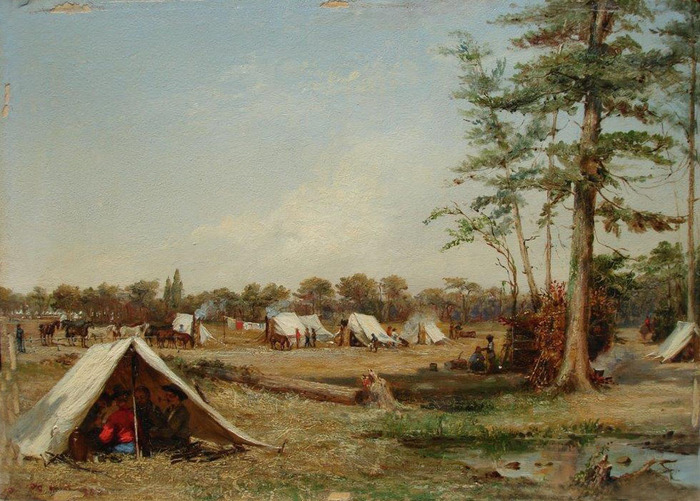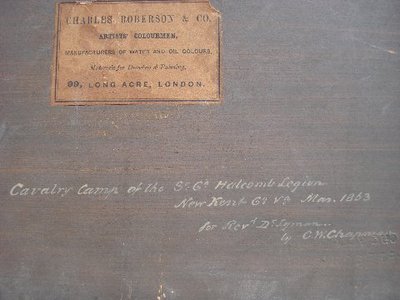Conrad Wise Chapman Cavalry Camp SC Halcomb Legion Mar. 1863
-
- Conrad Wise Chapman
- (1842 - 1910)
- South Carolina/Virginia / Mexico/Italy
- Image Size: 10 x 14
- Medium: Oil
- A scene from March 1863 Finished 1864
- Cavalry Camp SC Halcomb Legion Mar. 1863
- Contact for Price & Info
- View All By This Artist
Details
Provenance:
Probably Reverend Thomas
Benedict Lyman, fourth bishop of the Episcopal Diocese of North
Carolina, then descended within the family; through to Joseph Valentino
Toschi, JV Fine Arts Gallery, San Francisco, private Illinois
collection, c. 1960s.
Condition:
Minor losses, abrasions, fine craquelure, very subtle bowing, minor surface grime.
Notes:
Monogrammed, inscribed, and dated "CWC…186…" l.l.,
titled (Cavalry Camp SC Halcomb Legion....), dedicated, and
signed "…for Revd. Dr. Lyman/by C.W.Chapman" in whiting on the reverse,
also with the embossed stamp and label of Charles Robertson & Co.,
London, on the reverse. Signed and dated on reverse Mar. 1863. N.B. Chapman's path to becoming an official
artist of the Confederacy came full circle by way of Rome, Italy.
Chapman was born in Virginia, but in 1850, his artist father, John
Gadsby Chapman, moved his family to Rome to pursue the booming market
for works to Americans on the Grand Tour. Subsequently, J.G. Chapman,
who had trained professionally at the National Academy of Design,
apprenticed both of his sons as painters in Rome.Despite having been raised abroad, Chapman retained a deep sense of
loyalty to his Southern roots. At the outbreak of the Civil War, the
nineteen-year-old Chapman enlisted with the Confederacy, and sold what
works he could to pay for a return trip to America.Chapman saw battle in the years between 1861 and 1863, first in the
Company D, 3rd Kentucky Infantry Regiment, where he fought in the Battle
of Shiloh in Tennessee, and later in the 59th Virginia Infantry
Regiment. He made the switch from soldier to artist in 1863, when he was
recommended as a fine artist to the Department of South Carolina,
Georgia and Florida and headed to Charleston to assist General P.G.T.
Beauregard to document the city's fortifications for the general's
memoir.The present work, previously known only from an etching by J.G.
Chapman, depicts a day of respite in the Confederate army encampment of
the Holcombe Legion. The Legion, which saw battle in the defense of
Charleston and elsewhere in South Carolina, was formed on November 13,
1861, and named for Lucy Petway Holcombe Pickens, the spirited wife of
South Carolina Governor Francis W. Pickens.Though now indistinct, it can be surmised that the inscription and date
lower left read "ROMA 1864" which was the year that Chapman was given
leave to return to Italy to attend to his ailing mother.The work is dedicated to Dr. Lyman, believed to be Reverend Theodore
Benedict Lyman, D.D. (1815-1893), the fourth Bishop of the Episcopal
Diocese of North Carolina. Dr. Lyman traveled extensively in Europe and
the Middle East in the 1860s, serving as chaplain at the American
Embassy in Rome in 1865, and leading the St. Paul's Episcopal Church in
Rome from 1866 to 1879. Embossed stamp reads:
"ROBERTSON & CO./Long Acre London", and the label reads: "CHARLES
ROBERSON & CO./ARTISTS' COLOURMEN,/MANUFACTURERS OF WATER AND OIL
COLOURS,/Materials for Drawing & Painting,/99, LONG ACRE, LONDON."
on the reverse; A copy of a conservation report from Kuniej Berry
Associates, dated August 7, 2009, provided upon request. -
Biography
Conrad Wise Chapman (1842 - 1910)
Conrad
Wise Chapman was born in 1842, in Washington, D.C. and is known for his
depictions of the Civil War, in particular a series of thirty-one oil
paintings depicting the forts and batteries in the area of Charleston,
South Carolina.
He was the son of John Gadsby Chapman, an
Alexandria, Virginia artist and teacher, who moved his family to Rome in
1850 when Conrad was eight. While in Italy, Conrad was trained by his
father. Although he was raised in Europe, he was strongly attracted to
the Southern United States, and returned in 1861 to Virginia at the age
of nineteen to enlist in the Confederate Army as the Civil War began.
He was soon branded with the nickname of "Old Rome".
He
participated in the Siege of Vicksburg and received head wounds at
Shiloh. Upon recovery, he returned to Virginia, and then transferred a
year later to Charleston. There, on the recommendation of his father's
friend General Henry A. Wise, he became part of the staff of General
P.G.T. Beauregard. He was soon given orders to create a pictorial
record of the Confederate Army's defense of Charleston Harbor, and other
forts and batteries of the city.
Chapman completed a series of
illustrations between September 1863 and March 1864, which laid the
groundwork for thirty-one small paintings. These historical documents
are noted for their strong contrasts, deep perspective, and color
clarity. In 1864, Chapman had moved to Richmond, Virginia, along with
other artists such as portrait painter Edward C Bruce, landscapist John
Ross Key, Adalbert Volck, and the political caricaturist, William
Ludwell Sheppard. Perhaps never again would Richmond experience such a
concentration of creativity.
Chapman's notable series of
thirty-one paintings were painted, however, in Rome, where he had
traveled on leave, due to family illnesses. An example would be Fort Sumter Interior, Sunrise,
December 9, 1864 (oil on board, Museum of the Confederacy, Richmond,
VA). In this work he underscored the tragic dimensions of the
bombardment of the fort, contrasting the desolate destruction with the
beauty of its natural setting.
When Chapman returned to the
Confederacy, the war was almost over. After Lee's surrender, he followed
the Confederate General John B. Magruder to Mexico to serve the Emperor
Maxmillian. During the next seven years his paintings concentrated on
that country's landscape, the first American artist to do so. His
paintings of the Valley of Mexico constitute his other most significant
body of work. His works there have been compared to Mexico's Jose Maria
Velasco, a great nineteenth-century landscape artist.
Overall,
Chapman's works have great historical significance as Civil War record.
In addition, his art is included for the first time, in the category of
Southern, as well as American art.
He lived primarily in Rome,
Paris, and Mexico for the rest of his life, though Conrad Chapman died
in Hampton, Virginia, in 1910.
The
son of the artist John Gadsby Chapman, Conrad Wise Chapman was born in
Washington, D.C., but spent the majority of his youth in Rome, Italy.
There, his art education was overseen by his father and nurtured by the
extended community of American expatriate artists, notably the sculptors
Thomas Crawford and William Wetmore Story and the painters George
Loring Brown and Cephas Giovanni Thompson.
Though living abroad,
young Conrad was deeply versed in Southern tradition, so much so that
in 1861 he felt compelled to join the Confederate cause, later writing
that a “duty more sacred than even family ties rose to bid me move
forward and meet whatever my fate might be.” As a member of Kentucky’s
famous “Orphan Brigade,” Chapman suffered a serious head wound during
the April 1862 Battle of Shiloh, an injury that would plague him for the
rest of his life.
During Chapman’s recuperation in the summer of
1862, General P. G. T. Beauregard commissioned him to create a series
of works illustrating the siege of Charleston. The resulting group of
paintings provided the most detailed images of Confederate forces
produced by a painter in the South.
In March 1864, Chapman
returned to Rome as secretary to Bishop Patrick Neeson Lynch, President
Jefferson Davis’ commissioner to the papal states. Although he tried to
rejoin Confederate forces in March 1865, a blockade resulted in a
lengthy detour to Mexico, where he remained until 1866, painting several
large panoramas of the countryside which account for some of his best
received work. For the next few years, Chapman worked on commissions and
speculation in Rome, Paris and London. While living in London in 1871,
he suffered a mental breakdown—perhaps as a result of his war
injuries—and was confined to an asylum. The expense of his
hospitalization contributed to a sharp decline in the family fortunes.
For the balance of his years, Chapman would alternate between periods of
mental, physical, professional and financial instability, prompting a
series of moves between Mexico and the United States, often relying on
the generosity of others to support him.
While in Italy, Conrad
Chapman, along with his father and brother, enjoyed regular patronage
from American tourists who were fascinated by local color and ancient
ruins. In response, the family of artists executed landscapes and
paintings featuring the terrain and inhabitants of the Roman Campagna
and the Appian Way, ideal souvenirs of the rich Italian scene. Though
numerous examples of his father and brother’s Campagna scenes survive,
few by Conrad are known to exist. View of Italy exhibits the
clear light and warm color contrasts between the verdure of the land and
the costumes of the peasantry characteristic of the Chapman style.


